SKIN
Skin Fillers
Collagen and elastin are the main proteins found in the dermis (deep portion) of the skin, and over time may be degraded. Fat in the face can atrophy and facial volume can be depleted. This can cause skin depressions or wrinkles. Many materials have in the past been used to fill these depressions, but a number of new materials have become available for treating fine wrinkles and skin folds. A person’s own fat (autologous fat) can be transplanted into areas of the face to add volume and improve contour.
Skin fillers are a simple and effective way to augment small areas of the face. An office procedure, injectable fillers, such as Restylane, can be used to soften crow's feet, deep creases around the mouth and chin, depressed scars, or to give a fuller appearance to the lips, as shown here.
Shown here are before (left) and after (right) views of actual patients. Remember, every patient responds differently to surgery, and no one can be certain that he or she will get the results shown. However, these photos will illustrate the changes that are possible with these procedures.






Longer lasting injectable fillers such as Perlane can smooth folds for 6-12 months.Injectable fillers are no longer strictly for lines and folds. Instead, these materials can be used to restore lost volume to the face, and the results can last several months.


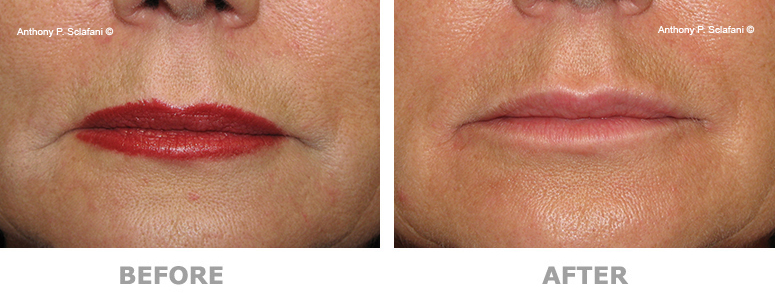
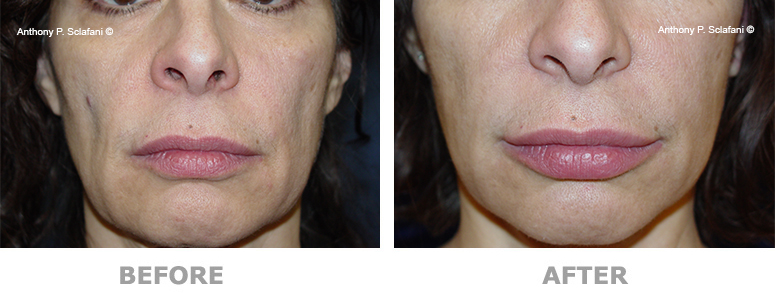
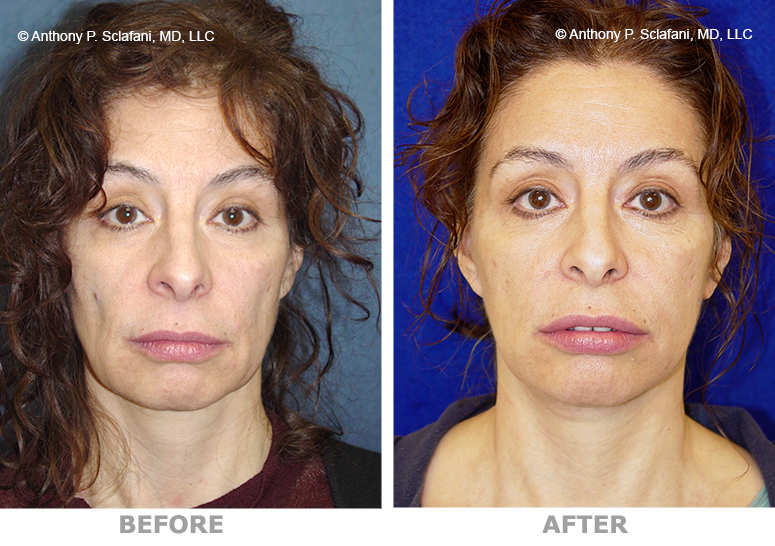
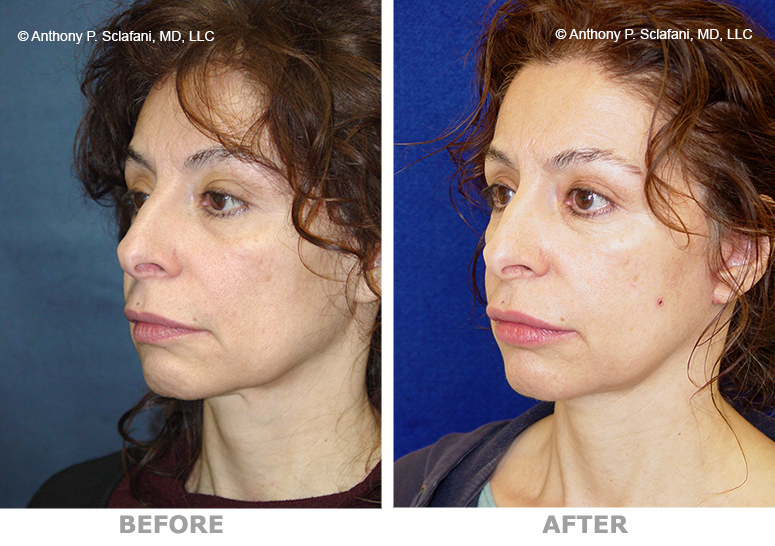
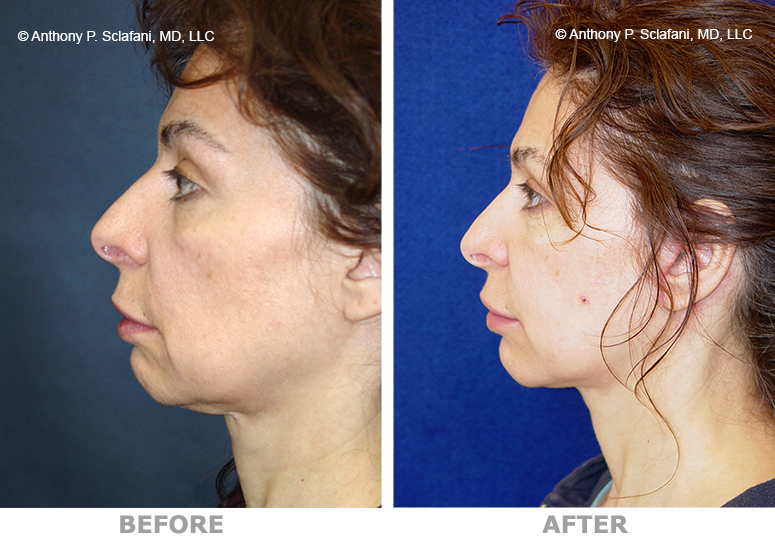
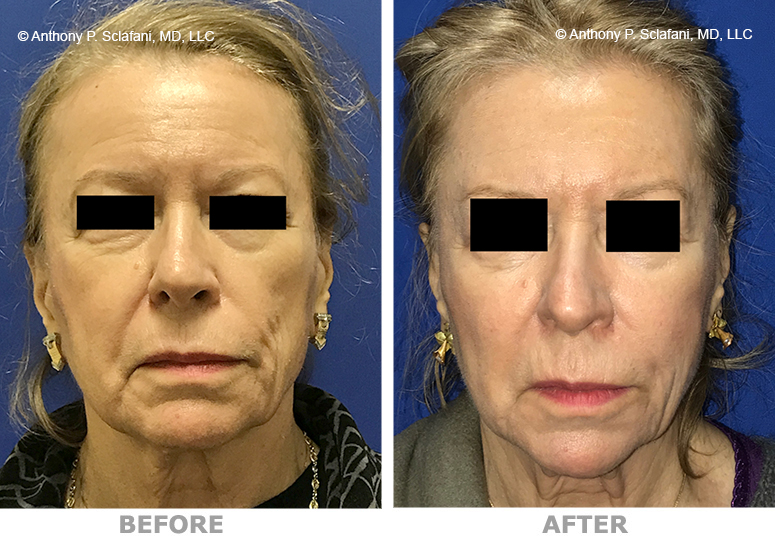
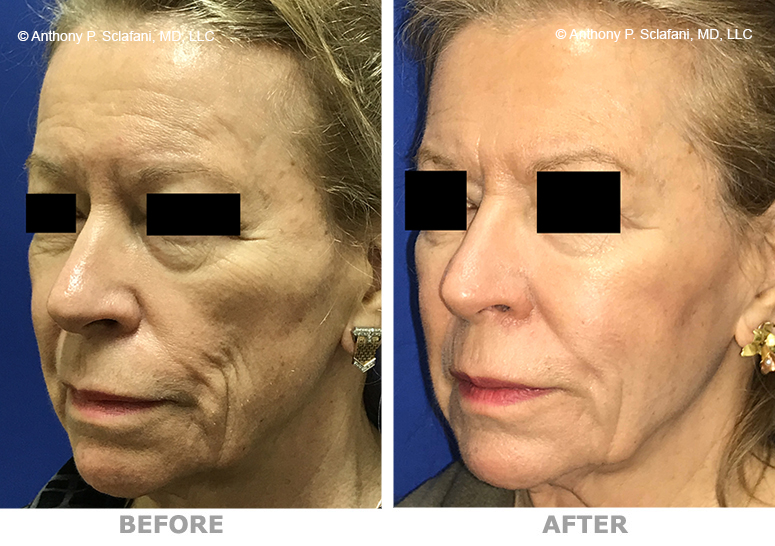
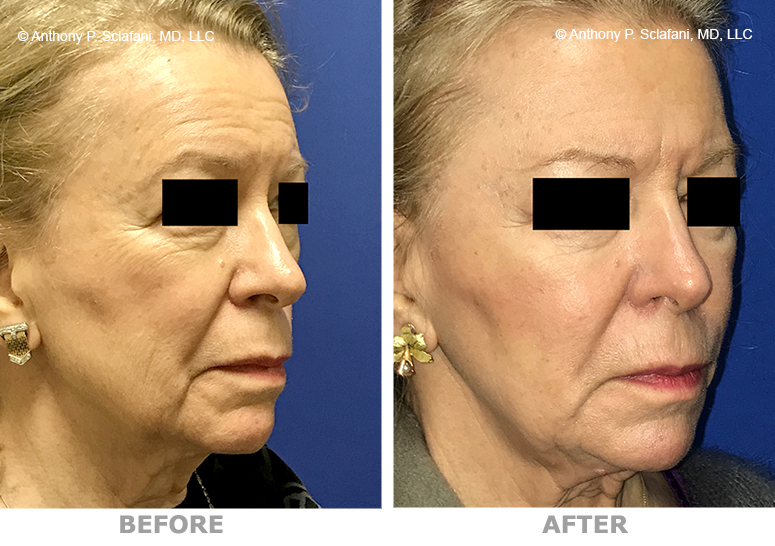
Fat transfer places a patient’s own fat into discrete locations to fill and shape the face.
Skin FIllers - Process and Procedure
The Process
Skin fillers can either be injected into the deeper layers of the skin or immediately below the skin through fine needles or implanted below the skin through tiny hidden incisions. Materials differ in their ability to correct different problems, as well as their longevity. The type of material used in a given patient depends upon the site, needed volume of augmentation and patient's goals. Dr. Sclafani can aid you in choosing the right material for you.
The Procedure
Derivatives of hyaluronic acid, such as Restylane, Juvederm, Volume, Refyne and Defyne have been approved by the F.D.A. for treatment of skin folds and wrinkles. Hyaluronic acid (HA) is a normal sugar component of the skin. The HA in these derivative fillers is derived from bacteria, then purified and treated to last longer. It is also injected through a small needle into the skin, and appears to last 5-8 months. There is a potential for intermittent swelling and redness of the treated area during the first 1-2 days after treatment; however, most patients are extremely satisfied with their result. Treatments that are particularly amenable to Restylane, Refyne, Defyne and Juvederm are laugh lines, frown lines around the mouth as well as those between the eyebrows, fine lines in the lips and for lip augmentation. Specific areas of the face can be treated with these to improve definition and contour. The results are exceptionally natural in appearance and feel.
Some patients choose to have multiple areas treated at the same time, for a "VolumeLift". Typically, this includes treatment of the brows, under eye area, cheeks, laugh lines and jawline, and occasionally some other facial areas. While the VolumeLift does not take the place of a standard facelift, it can help give the entire face a more youthful appearance.
Another filler, Radiesse, is composed of microscopic calcium beads which become surrounded by fibrous tissue until they dissolve harmlessly. This material is an excellent option for longer-lasting results in the laugh lines, cheek and chin.
Fat can be harvested from a patient's abdomen, thigh or buttock and reinjected under the skin in areas of tissue deficiency, such as the lips or skin folds. Through a small incision (often inside the belly-button), fat is harvested, then concentrated and reinjected under the skin through tiny access incisions. Fat can be used to augment cheekbones, lips, chins or fill depressions like laugh lines. There is usually a 1-2 week period of swelling after treatment, and the amount of fat that persists varies from patient to patient.
What to Expect After Skin Fillers
Certain physical changes are expected following skin and soft tissue fillers. Some individuals experience all of the following and others only some. The degree to which each person is affected is variable and unpredictable.
DIET
You can resume a normal diet immediately after treatment with Restylane, Refyne, Defyne, Juvederm, Voluma or Radiesse. After placement of fat, into the lips, it is best to avoid significant manipulation of the lips for 48 hours, so foods that require extensive chewing (for example steak, crusty breads) should be avoided. If the implants were placed under anesthesia, it is best to start with liquids (soup, juices, etc.) immediately after surgery. Once the anesthesia has worn off and your appetite returns, regular food is allowed.
DRESSINGS/SUTURES
Restylane, Refyne, Defyne, Juvederm, Voluma and Radiesse are injected through small needles into or under the skin. No incision, sutures or dressings are necessary. Fat is introduced through a small tube placed through a tiny (2-3 mm) incision, which is easily closed with a single suture. All sutures are removed 7 days after surgery.
ACTIVITY AFTER SURGERY
In order to allow your tissues to heal properly, we ask that you refrain from speaking, smiling or moving the lips for 2 hours after Restylane, Refyne, Defyne, Juvederm, Voluma or Radiesse injections, and 4-6 hours after placement of fat.
SWELLING
Swelling of tissues is expected and generally resolves by 2-4 hours after collagen injection. This represents the fluid in the injection being absorbed by the body, while the protein injected remains behind. Some patients treated with Restylane, Refyne, Defyne, Juvederm, Voluma or Radiesse may have mild fluctuating bruising and swelling for the first 24- 48 hours. Fat transfer patients typically experience 7- 10 days of post-operative swelling.
BRUISING
Make-up can be applied the morning following Restylane, Refyne, Defyne, Juvederm, Voluma or Radiesse injections to conceal any bruising. Application of an ice compress to the treated area for the first hour after injections (first 24- 36 hours for fat) will help minimize bruising.
NUMBNESS
A feeling of numbness in the treated area will occur and usually lasts for 1-3 hours after injection. This is due to the local anesthetic. Patients treated with fat will have numbness of the area typically for 2-3 weeks afterwards.
